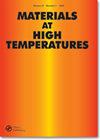同步加速器硬x射线纳米探针显微镜的原位液体环境
IF 0.9
4区 材料科学
Q4 MATERIALS SCIENCE, MULTIDISCIPLINARY
引用次数: 1
摘要
在模拟系统自然操作条件的环境中研究化学反应可以为动态氧化过程提供重要的见解。透射电子显微镜(tem)和x射线纳米探针允许使用成像和光谱学来获取这些过程的纳米级化学和结构信息。然而,受控的操作条件和约束使得原位样品环境的设计和实现具有挑战性。在这里,我们概述了在金刚石光源下硬x射线纳米探针光束线(I14)的原位液体样品环境的设置。液体环境允许对暴露在液体流中的样品进行成像和光谱分析,加热温度可达80℃。通过铁腐蚀实验验证了该方法的可行性。样品池的设计为x射线和电子显微镜相结合进行液体样品的原位多长度尺度成像和光谱分析提供了前景。本文章由计算机程序翻译,如有差异,请以英文原文为准。
An in situ liquid environment for synchrotron hard X-ray nanoprobe microscopy
ABSTRACT Studying chemical reactions in an environment that closely mimics the system’s natural operating conditions can offer crucial insights into dynamic oxidation processes. Transmission Electron Microscopes (TEMs) and X-ray Nanoprobes allow the use of imaging and spectroscopy to access nanoscale chemical and structural information about these processes. However, the controlled operating conditions and constraints make the design and implementation of in situ sample environments challenging. Here, we outline the setup of an in situ liquid sample environment for the Hard X-ray Nanoprobe beamline (I14) at Diamond Light Source. The liquid environment allows for the imaging and spectroscopic analysis of samples exposed to liquid flow, with heating up to 80℃. The capability is demonstrated with an example experiment studying iron corrosion. The design of the sample cell offers the prospect of combining X-ray and electron microscopy for the in situ multi-length scale imaging and spectroscopy of samples in liquid.
求助全文
通过发布文献求助,成功后即可免费获取论文全文。
去求助
来源期刊

Materials at High Temperatures
工程技术-材料科学:综合
CiteScore
1.90
自引率
15.40%
发文量
58
审稿时长
>12 weeks
期刊介绍:
Materials at High Temperatures welcomes contributions relating to high temperature applications in the energy generation, aerospace, chemical and process industries. The effects of high temperatures and extreme environments on the corrosion and oxidation, fatigue, creep, strength and wear of metallic alloys, ceramics, intermetallics, and refractory and composite materials relative to these industries are covered.
Papers on the modelling of behaviour and life prediction are also welcome, provided these are validated by experimental data and explicitly linked to actual or potential applications. Contributions addressing the needs of designers and engineers (e.g. standards and codes of practice) relative to the areas of interest of this journal also fall within the scope. The term ''high temperatures'' refers to the subsequent temperatures of application and not, for example, to those of processing itself.
Materials at High Temperatures publishes regular thematic issues on topics of current interest. Proposals for issues are welcomed; please contact one of the Editors with details.
 求助内容:
求助内容: 应助结果提醒方式:
应助结果提醒方式:


